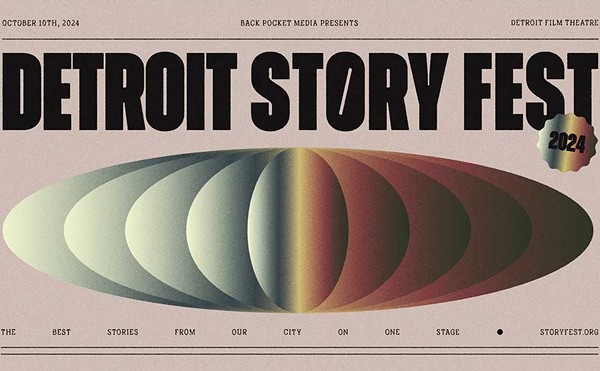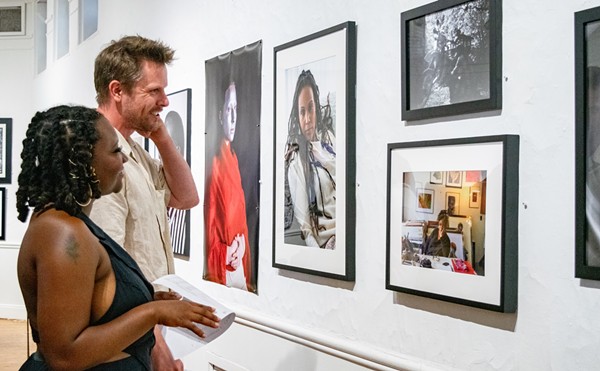"Astonish me!"
According to a 20th century legend, that's what Ballets Russes impresario Serge Diaghilev once said to young Jean Cocteau, as he explained to the budding poet and filmmaker what he wanted from art above all. For viewers who expect the same kind of aesthetic jolt today, Outpost, the new photography show at Ferndale's Susanne Hilberry Gallery, delivers a prime cut of astonishment from three unique visions of contemporary urban space. Curated by photographer and sometime-Detroiter Brian D. Mahoney, this selection of a dozen oversized color prints presents subtle but disturbing reflections on the natural environment, the morning-after migraine of urban architecture, and the uncanny netherworlds in between. The frightening emptiness at the core of these photographs temporarily transforms the luxuriously wide-open space at Hilberry Gallery into a vast, even lonely, space.
Since Tim Davis, John Lehr, and Michael Vahrenwald are all graduates of Yale's MFA program in photography, we might expect the similarities in their work to take center stage, but each artist maintains a stark individuality within shared thematic concerns. Davis, for example, packs his shots with information as he hints at life in all of its creepy resilience, like a stroller in the park turning over a rock to expose things we'd rather not consider. A hair-raising drama of light takes place in his "Exxon I," as a shadow, a relentless oil slick, climbs the side of a red-shingled, wood-frame house, while just above it the reflected light from an Exxon station glows like some postapocalyptic sunrise.
The proverbial "devil in the details" of this image lets us fantasize any number of abject scenarios, from a case of midnight stalking to blood-curdling voyeurism. There's a motionless fan blade in the attic window, a glimpse of scaffolding that seems to hold up part of the roof and a "beastly" reflection in a lower window, complete with gazing, vacant eyes and yawning mouth, all basking in the station's garish neon. It's like a frame from David Lynch's Blue Velvet or David Cronenberg's The Dead Zone, in an architectural style that's pure dissipated déjà-vu. Another Davis composition, "Dealership," piles up night-lit signifiers in claustrophobic panorama: Leaves of bushes in the foreground reflect the shine from streetlamps, and a blue wooden arrow points incomprehensibly to something indicated on its unseen other side. It's impossible to ignore the political current just below the surface of these pictures.
Each of the four "Sound & Fury" prints by John Lehr features a totem-like pillar perfectly centered in a violated landscape, and each accompanies its surroundings the way a fashion accessory gets paired with a particular outfit: a white pillar in a high-contrast shot of a gleaming industrial park, a dark 200l monolith in a suburban highway sunset, etc. In "Marlboro, VT," we soon realize that what first looks like a brown totem pole is an exactly framed side-view of a roadside billboard, leaning slightly to the left in symbolic disconnection from its surroundings. It so absolutely doesn't belong that the reference to Native American totems, and their ritual immersion in the life of the land, explodes in painful irony. Once again, pristine aesthetics usher in the political.
Finally, in three large panels by Michael Vahrenwald, we get something like a gorgeous documentation of late capitalism's acid reflux. Vahrenwald mounts, but doesn't frame, his huge prints, giving them added impact, as if letting us look through a series of chilling slices in a mall facade. At first, we imagine taking a glance through the back window of a big-box store — but the expanse of grass in "Stepped Hill #2, Home Depot, East Greenbush, NY" is something we'd never pause long enough to notice — just some anonymous backdrop to the daily grind of generating profit. But then the print's reverb hits us, and we imagine Home Depot leveling the land, piling up the slope around one of its stores under construction, then seeding the surrounding landscape. With another look back at these pictures we notice machine-made layers in the mowed grass, delicate frost that returns to do its job regardless of human affairs, and the moonscape-like solemnity of a brown field stretching to an artificial horizon.
The dark matter and energy of theoretical physics seem to saturate the upper portions of these works, becoming an essential element of their makeup, as much as do formal echoes of recent color field painting. As in science's most recent speculations about the origin and workings of the universe, Vahrenwald's sobering visions of the hidden outback of our consumer culture are glimpses of an encroaching unknown, one with as yet undetermined consequences for our spiritual lives.
Outpost: photographs by Tim Davis, John Lehr and Michael Vahrenwald, through April 28 at Susanne Hilberry Gallery, 700 Livernois St., Ferndale; 248-541-4700.
George Tysh teaches literature and writing at the Roeper School. Send comments to [email protected]





